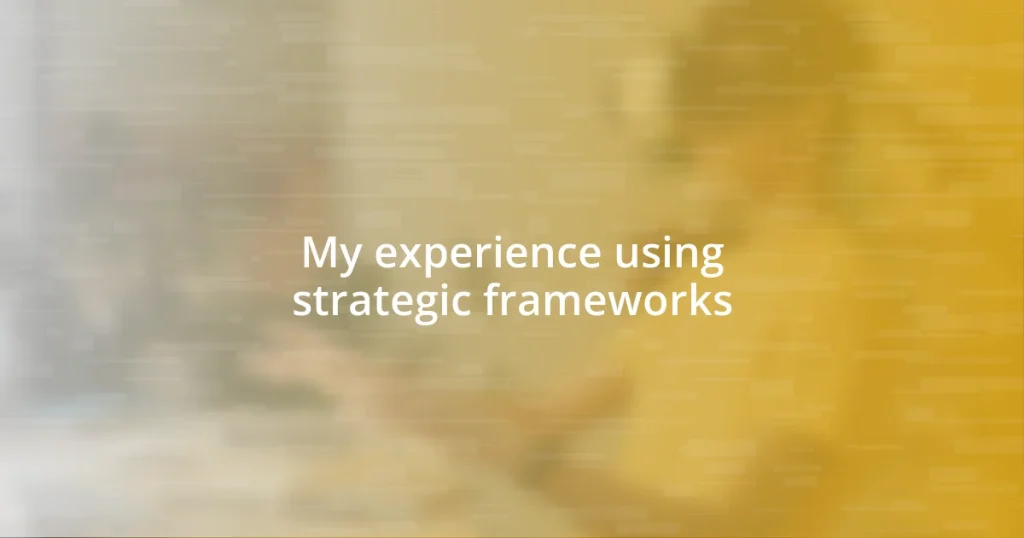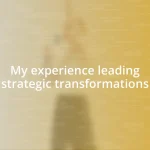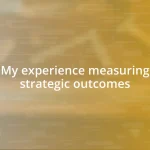Key takeaways:
- Strategic frameworks act as mental maps that provide clarity, enhance collaboration, and improve decision-making in business contexts.
- Common frameworks like SWOT Analysis, Porter’s Five Forces, and Balanced Scorecard offer unique strengths for addressing specific challenges and aligning team efforts.
- Successful implementation of frameworks requires understanding objectives, involving diverse perspectives, and being flexible to adapt strategies as needed.

Introduction to strategic frameworks
Strategic frameworks are more than just tools; they are the mental maps that guide our decision-making processes. I remember the first time I encountered a strategic framework—I was tasked with launching a new product, and without that clear structure, I felt lost. How could a simple model make such a difference in clarity and focus?
These frameworks serve as scaffolding for our ideas, allowing us to organize our thoughts and present them coherently. Think of them as a GPS for business planning—while the destination is up to you, the framework helps chart the course. I often find myself reflecting on how frameworks have transformed chaotic brainstorming sessions into productive strategy meetings; it’s empowering to witness what structure can do.
Moreover, embracing strategic frameworks allows for greater collaboration among teams. Have you ever felt like everyone was speaking a different language in meetings? I’ve been there. When I started using frameworks, it bridged that gap. They made it easier for everyone to align their vision and contribute meaningfully, igniting discussions that felt more cohesive and focused.
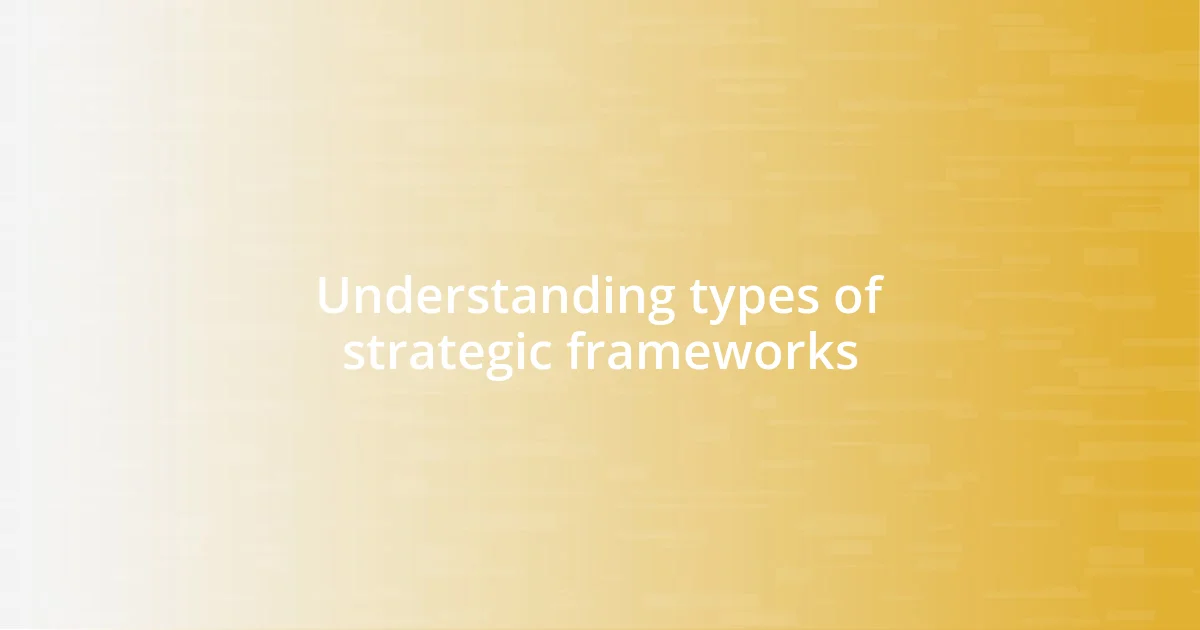
Understanding types of strategic frameworks
Understanding the types of strategic frameworks can greatly influence how we approach our objectives. I’ve come across various frameworks throughout my career, but some truly stood out for their unique applications. Each type has its strengths, whether it’s simplifying complex problems or enhancing team collaboration. Here’s a breakdown of some common types I’ve found particularly effective:
- SWOT Analysis: A classic tool focusing on Strengths, Weaknesses, Opportunities, and Threats. I remember using this approach for a marketing campaign, and it illuminated opportunities I hadn’t considered.
- Porter’s Five Forces: This framework helps evaluate industry competition, and I utilized it to assess market entry strategies for a startup. The insights were eye-opening!
- Balanced Scorecard: This comprehensive approach aligns business activities to the vision and strategy of the organization. I found it particularly valuable for tracking performance across various departments.
- Value Proposition Canvas: Focusing on customer needs, this framework helped me refine a product’s market fit during a challenging product launch.
It’s fascinating how each framework offers a lens through which to view challenges. The beauty lies in recognizing the right one for your situation, transforming hurdles into stepping stones.

Benefits of using strategic frameworks
Using strategic frameworks can lead to improved clarity in decision-making processes. Reflecting on my experience, I remember a time when a project felt overwhelming. By implementing a structured framework, choices became clearer and allowed me to focus on the most impactful actions. This wasn’t just about organizing work; it was about transforming chaos into a well-defined strategy that everyone could rally behind.
Moreover, strategic frameworks foster enhanced collaboration within teams. I recall a particularly challenging project where team members had different interpretations of our goals. By adopting a common framework, we all spoke the same language. Suddenly, discussions became constructive, as everyone could contribute confidently, knowing they were aligned with a shared vision. This sense of unity not only boosted morale but also dramatically increased our productivity.
Finally, the ability to measure progress and outcomes is another significant benefit. For instance, after integrating a framework to track our project milestones, we began celebrating small victories that motivated the entire team. The structured approach allowed us to reflect on our achievements, adjust strategies, and maintain momentum. In my experience, these frameworks provide a tangible way to visualize progress, reminding us of how far we’ve come.
| Benefit | Description |
|---|---|
| Clarity in Decision-Making | Frameworks help clarify choices, making it easier to focus on impactful actions. |
| Team Collaboration | They foster unity by aligning team members under a shared strategic vision. |
| Progress Measurement | Frameworks offer a tangible way to track milestones and celebrate achievements. |

Steps to implement strategic frameworks
Implementing strategic frameworks begins with a clear understanding of your objectives. Once I set specific goals, I often find it beneficial to involve my team in the initial discussions. This not only fosters ownership but also sparks diverse ideas that can shape the framework’s direction. Have you ever noticed how collaborative brainstorming can unlock unexpected insights?
Next, I focus on selecting the appropriate framework that aligns with our objectives. It’s like picking the right tool from a toolbox; the right choice can make all the difference. In one project, choosing a Balanced Scorecard led us to not only track our KPIs but also integrate feedback loops from various departments. This adaptability showed me how important it is to remain flexible in our approach.
Lastly, I prioritize establishing a roadmap for implementation. This includes defining roles and responsibilities, setting timelines, and creating check-in points to review progress. I’ve experienced projects flounder without clear accountability. By creating a structured timeline, I was able to ensure my team stayed aligned and engaged, prompting me to ask, how often do we really reflect on our progress throughout a project? That’s where the magic happens!
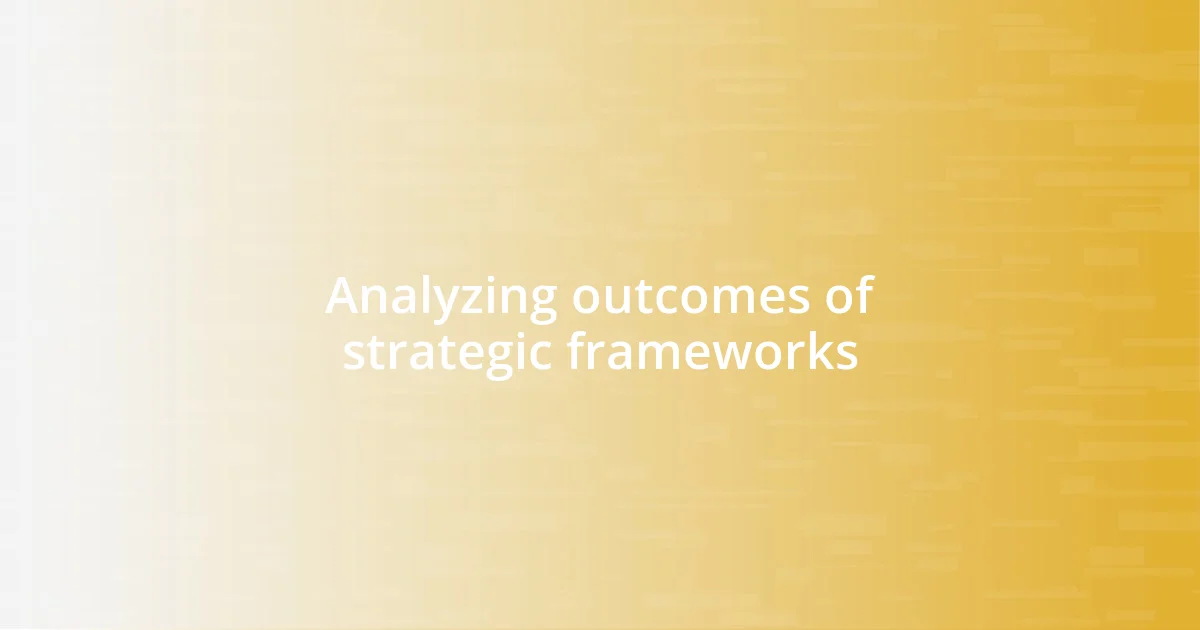
Analyzing outcomes of strategic frameworks
When it comes to analyzing the outcomes of strategic frameworks, I find it essential to set clear metrics right from the start. For instance, I recall a project where we quickly realized that our initial success measures weren’t capturing the full picture. By revisiting these metrics mid-project, we unlocked deeper insights that transformed our understanding of what “success” really meant. It’s a crucial reminder that the right metrics can turn vague goals into tangible outcomes.
In my experience, reflecting on outcomes also involves encouraging honest feedback from team members. I once led a debriefing session after completing a significant initiative. To my surprise, the feedback highlighted aspects of the framework that hadn’t worked well for everyone. Those candid conversations not only helped us refine our approach for future projects but also built a culture of trust within the team. How often do we create spaces for such unrehearsed discussions?
Another important aspect of analysis is recognizing patterns over time. I distinctly remember analyzing several completed projects where we used a specific framework. As I observed recurring successes and challenges, a clearer picture emerged of how different elements of the framework influenced our results. It’s almost like piecing together a puzzle; the more projects you analyze, the more you can anticipate what strategies will yield the best results in future endeavors. When was the last time you took a step back to see the bigger picture? It might just open up new avenues for improvement.
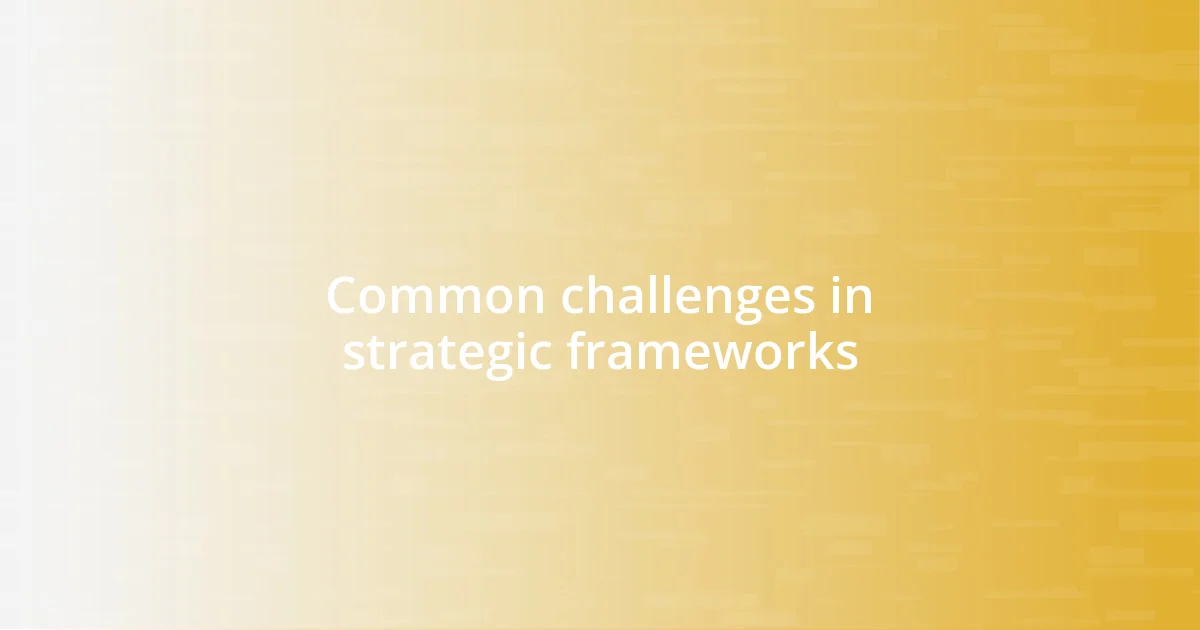
Common challenges in strategic frameworks
One of the most common challenges I encounter with strategic frameworks is the initial resistance from team members. I remember a time when I proposed a new framework to a group that was already comfortable with the status quo. The pushback was intense, and it took several meetings to address their concerns and highlight the benefits. Have you ever faced similar skepticism? It’s important to recognize that change can be daunting, and it often requires patience and open communication to help everyone transition with confidence.
Another hurdle I frequently see is misalignment between the framework and the organization’s culture. For instance, during a project, I introduced a detailed, top-down framework that didn’t resonate with our team’s collaborative spirit. The result? Frustration and confusion. This misalignment showed me how crucial it is to ensure that the strategic approach complements the existing values and behaviors within the team. Isn’t it fascinating how deeply culture impacts our effectiveness?
Lastly, the complexity of certain frameworks can create paralysis by analysis. There was a project where we spent so much time dissecting different strategic options that we stalled in our execution. It made me realize how easy it is to get caught up in theoretical models rather than focusing on practical, actionable steps. Have you ever gotten lost in the details and forgot to move forward? Sometimes, simplifying the framework and emphasizing action can reignite momentum and drive real progress.

Lessons learned from my experience
Reflecting on my journey with strategic frameworks, I’ve learned that flexibility is key. I recall a time when an unexpected market shift forced us to pivot from our planned approach. Initially, it felt chaotic, but adapting our strategy led to surprising results. Have you ever had to rethink your path mid-journey? Those moments, while uncomfortable, can lead to incredible growth and innovation.
One lesson that stands out for me is the significance of involving diverse perspectives early on. I once oversaw a strategic initiative where we limited our input to just a few key stakeholders. This narrow focus cost us dearly, as we later realized we had missed crucial insights from other team members. It was a humbling experience that taught me the value of collaboration. How often do we truly harness the full potential of our teams before moving forward?
Lastly, I discovered the power of celebrating small wins along the way. During a particularly long project, I initiated short check-ins to recognize the team’s progress, no matter how minor. These moments of acknowledgment lifted morale and kept everyone engaged, transforming our approach into a shared journey. Have you seen how even little victories can spark motivation? Recognizing these moments fosters resilience and drives momentum that carries you through challenging phases.










